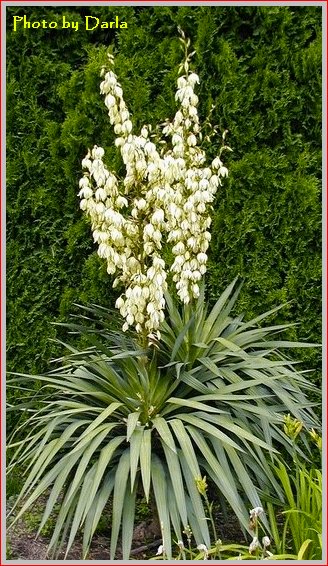

United States Dispensatory 1926
Boericke�s Homeopathic Materia Medica
A Dictionary of Practical Materia Medica. John Henry Clarke, M.D.
Compiled and Edited by Ivor Hughes
1. U.S.D. 1926
Yucca filamentosa L.,
familiarly known as Adam's needle or Spanish bayonet, a liliaceous Mexican plant, has long been used by the Indians as a cleansing agent and contains a considerable amount of a special saponin. It has become a plant of some commercial importance in Kansas under the colloquial name of soap weed. (See D. C., 1917, lxi, 42.)The saponins have been employed in beverages to give a frothy or foaming effect. The detection of small amounts is very difficult. One method that has been suggested is to test the hemolytic effect of the separated froth.
Many of the saponins are highly poisonous and are therefore known as
sapotoxins. The toxic effects appear to be due to their affinity for
cholesterin and perhaps also lecithin. By virtue of this combination with
these important lipoid bodies they are irritant to mucous membranes and
when introduced into the circulation destroy the red blood cells and
exercise potent effects upon the central nervous system. The variability
in their toxic powers may be gauged by the fact that diocin, when mixed
with blood, in as dilute solution as 1 in 400,000, will cause hemolysis
while chamaelirin (from Helonias) requires a concentration of 1 in 700.
Most of the toxic saponins are unable to pass through the intestinal
mucous membranes and when taken by the mouth cause only local irritation
of the alimentary canal; agro stemma is a noteworthy exception to this
rule. When introduced into the circulation in moderately toxic doses the
most obvious symptoms produced by the sapotoxins, are usually on behalf of
the nervous system; convulsions followed by motor weakness, and even
complete paralysis. Accompanying these nervous symptoms there is often
weakness of the heart and evidence of irritation of the serous membranes
and eliminating organs. After larger quantities, there is, besides the
nervous manifestations, marked failure of the circulation, and vomiting
and purging�the ejecta often being bloody. Death is usually due to
respiratory failure, but may occur after some days of general exhaustion.
When locally applied sapotoxins destroy the contractility of the muscles
and the conductivity of the nerves. For studies of the physiological
effects of saponins see Ransom (D. M. W., 1901, xxvii, p. 194), Brandl (A.
E. P. P., 1905, liv, p. 245 and 1908, lix, p. 299), Yagi (A. B. P. P.,
1911, lxiv, p. 141) and Kobert (Biochem. Handlex, 1914, vol. vii).
Boericke�s Homeopathic Materia Medica
YUCCA FILAMENTOSA. (Bear-grass)
So-called bilious symptoms, with headache. Despondent and irritable.
Head. � Aches as if top of head would fly off. Arteries of
forehead throb. Nose red.
Face. � Yellow; tongue yellow, coated, taking imprint of teeth.
[Merc.; Pod.; Rhus.]
Mouth. � Taste as of rotten eggs. [Arnica,.]
Throat. � Sensation as if something hung down from posterior
nares; cannot get it up or down.
Abdomen. � Deep pain in right side over liver, going through
back. Stool yellowish brown, with bile.
Male � Burning and swelling of the prepuce, with redness at
meatus. Gonorrhea. [Cann.; Tussil.]
Skin. � Erythematous redness.
Dose. � Tincture, to third potency.
Clarks Dictionary of Practical Materia Medica
Yucca Filamentosa, Linn (Bear Grass)
Nat. Ord. Melanthaceae (Liliaceae).
Part used ; Tincture of root and leaves when not in flower.
Tincture of flowers.
Clinical Indications. Biliousness. Coryza. Diarrhoea, Flatulence,
odourless. Headache; temporal. Post-nasal catarrh. Throat, granular.
Characteristics. Yucca was proved by Rowell and four others in the
30th. Farrington gives these indications. Biliousness with pain going
through upper part of liver to back. Bad taste in mouth. Stools loose and
contain an excess of bile. Much flatus passed by rectum. Frontal or
temporal headache with frequent flushing of face. Face sallow. Tongue
coated yellow and taking imprint of teeth. Dull ache in centre of liver.
Abdomen sensitive. Frequent passage of flatus and of watery,
yellowish-brown stools. The tongue of Yuc. is usually a bluish white. As
with many liver disorders, there is chilliness: cannot bear to be away
from the fire. Among the sensations are: As of something hanging down from
back of nares. As if cold air blowing on left side of scalp. The symptoms
are: <; B noise; motion; pressure. Griping pain is > bending
forward.
Abridged and edited from :
A Dictionary of Practical Materia Medica.
By John Henry Clarke, M.D.
If you did not find what you were seeking, use the site search box at the top right hand of the page or else peruse the site library.
![]()